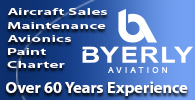In the closing days of 2015, Congress enacted a tax package that retroactively revived, and extended into the future, important tax incentives of significant benefit to the general aviation industry. This was a welcome deviation from the legislative routine in recent years of allowing these incentives to expire with the start of each new year, only to retroactively reinstate them as year-end approaches—leaving taxpayers during the interim on tenterhooks, guessing what tax laws they will be subject to. Two tax incentives that are of particular value to the general aviation industry are Bonus Depreciation and 179 Expensing.
50 percent Bonus Depreciation
Under the Bonus Depreciation rules, purchases of new aircraft, as well as purchases of new equipment installed in used aircraft, are eligible for
an accelerated bonus-depreciation allowance in the year they are placed in service. For tax years 2015, 2016, and 2017, the bonus-depreciation allowance will be 50 percent of the cost; this reduces to 40 percent in 2018, 30 percent in 2019, and is phased out thereafter (although some 2020 acquisitions may qualify, where a written binding purchase contract was in place before 2020).
The additional first-year depreciation deduction is allowable both for regular income tax purposes and alternative minimum tax. Aircraft eligible for bonus depreciation must be new, used primarily for qualified business purposes, and meet other tests necessary to qualify for depreciation under the modified accelerated cost recovery system (MACRS). Bonus depreciation excludes property acquired under written binding contracts in effect prior to January 1, 2008. Special rules may apply to agricultural and firefighting aircraft.
Bonus depreciation is generally limited to factory-new property. In calculating cost eligible for bonus depreciation, a taxpayer may include the cost of installation, inspection, certification, and the like. If refurbished equipment includes both new and used components, the entire cost may be subject to bonus depreciation if less than 20 percent of the total value is attributable to the used component/s.
Section 179 Expensing Election Retroactively Enhanced and Made Permanent
The expensing election, which is available to both new and used business property, is in addition to the bonus depreciation allowance, and can benefit businesses which engage in eligible investments of less than $2,500,000 within the year. The expensing allows a taxpayer to write off up to $500,000 of equipment, but in no case more than the taxpayer’s income. Further, the available write-off decreases dollar-for-dollar to the extent that the taxpayer’s total investment in qualifying property for the year exceeds $2,000,000. The major advantage of the expensing election over bonus depreciation is its availability for used property.
Ordering of Deductions
When both bonus depreciation and Section 179 expensing are available and desired, the deductions are calculated by applying Section 179 first, followed by bonus depreciation, and last the regular depreciation allowance.
Example: New non-commercial aircraft placed in service within the first three quarters of the year by a taxpayer able to use the Section 179 deduction:
Aircraft Cost: $2,200,000
179 Deduction: $300,000 ($500,000 reduced by ($2,200,000-$2,000,000))
Bonus Depreciation: $950,000 (50% of ($2,200,000 – $300,000))
Ordinary Depreciation: $190,000 (20%, the normal first-year depreciation amount) of the remainder
— (i.e., ($2,200,000 – $300,000)- $950,000)
Total Yr. 1 Write-Off: $1,440,000
% of Purchase Price: 65%
Conclusion
Although Congress has encouraged investment in new equipment through these incentive provisions, taxpayers must exercise extreme care to sustain the deductions under IRS scrutiny. The IRS has a number of tools at its disposal to claw back tax savings so graciously provided by the legal tax incentives. Careful adherence to the myriad use, structuring, and recordkeeping requirements is particularly important where taxpayers expect to receive large tax benefits in a given year. It is critical to consult with a qualified expert, not only on whether a particular transaction qualifies for the incentives, but also on whether associated tax rules may take away benefits the incentive programs may have made available. This article is merely an overview of the topic, and not necessarily comprehensive.
Jonathan Levy is Legal Advisor at Advocate Consulting Legal Group, PLLC, a law firm whose practice is limited to serving the needs of aircraft owners and operators relating to issues of income tax, sales tax, federal aviation regulations, and other related organizational and operational issues.
Tax Disclosure: Any tax advice contained in this communication (including any attachments) is not intended or written to be used, and cannot be used, for the purpose of (i) avoiding penalties under tax laws, or (ii) promoting, marketing or recommending to another party any transaction or matter addressed herein.


 Twin Commander flown by Erick Teeters & John Kelley.
Twin Commander flown by Erick Teeters & John Kelley. 
